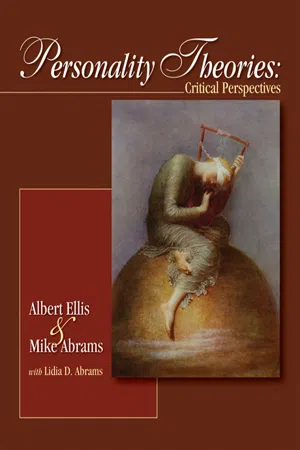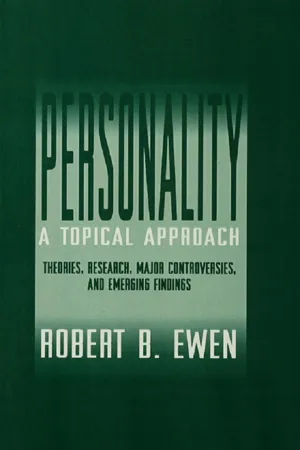Psychology
Trait Theories of Personality
Trait theories of personality propose that individuals possess certain enduring characteristics, or traits, that influence their behavior, thoughts, and emotions. These traits are relatively stable over time and across different situations, and they are used to describe and understand individual differences in personality. Trait theories have been influential in the field of psychology and have contributed to the development of personality assessment tools.
Written by Perlego with AI-assistance
Related key terms
8 Key excerpts on "Trait Theories of Personality"
- eBook - ePub
Personality Theories
Critical Perspectives
- Albert Ellis, Mike Abrams, Lidia Dengelegi Abrams(Authors)
- 2008(Publication Date)
- SAGE Publications, Inc(Publisher)
Most personality theories pay at least lip service to the importance of empirical research, but trait theories can lay claim to being defined by it. The very usefulness of the concept of a trait is that it can be operationally defined and investigated through use of the scientific method. In this chapter, this operational approach is shown at work in the various definitions of traits. Preliminary Definitions Allport (1961) defined a trait in partly biological terms as a “neuropsychic structure having the capacity to render many stimuli functionally equivalent, and to initiate and guide equivalent forms of adaptive and expressive behavior” (p. 347). Another definition of trait from Pervin, Cervone, and John (2005) is that a trait represents “the consistency of an individual’s responses to a variety of situations” (p. 8). A trait, therefore, is an element of personality that causes individuals to act in a similar fashion across different social settings. For example, a person who has the trait of extroversion is likely to be outgoing and sociable in most situations rather than shy and inhibited. If human beings differ in terms of personality—and most of us would agree that they do—traits are one way to measure those differences. The definitions of traits offered by different psychologists tend to have these elements in common: Traits are stable within a given individual. Traits vary among individuals. Traits can be measured. Traits are responsible for closely related behaviors. Traits and Attitudes There are clear relationships between traits and attitudes, although the distinction between them is often arbitrary. If these concepts are to have any value, however, they must first of all correlate with and predict behavior. Penrod (1986) made the point that although attitude refers to a behavioral disposition, the tacit assumption in attitude research is that there is a direct correlation between our attitudes and our behaviors - eBook - ePub
Personality, Design and Marketing
Matching Design to Customer Personal Preferences
- Gloria Moss(Author)
- 2017(Publication Date)
- Routledge(Publisher)
The first section in this chapter compares the viewpoint that traits are an inclusive set of dispositions shared by all people against a different viewpoint that an individual’s underlying traits are exclusive to only that particular person. The mainstream trait approach largely adopts the former perspective, and this is compared to the view of personality as being essentially idiosyncratic rather than comparable across every one of us. In the second section, the comparison is made between psychodynamic perspectives (that tend to focus on unresolved early life experiences and the unconscious mind) and cognitive theories (that examine the largely consciously accessible thinking habits that make people who they are). The third section addresses the issue of the role of biology versus experience on personality, examining evidence of inherited temperamental differences between individuals and discussing how experience and nature interact in the development of personality across the lifespan. The fourth section of the chapter discusses a set of theories and research about personality that can be subsumed under the umbrella of positive psychology. Historically, personality theorists have often also been clinicians with an interest in personality pathology. Positive psychology strays from this tradition by considering the overarching driving force of human nature as leaning towards healthy personality development and flourishing.Are there universal personality traits or are people unique?
Most definitions of the term ‘traits’ mention that they are consistent and stable patterns of thoughts, feelings and behaviours that differentiate people from each other. Therefore it is safe to say that we can think of the collection of individual traits that one possesses as being the linchpin of one’s personality. The major difference between different factions of personality researchers and theorists is whether to identify a set of universal traits against which people can be compared or whether to focus on a person’s own underlying personality traits as particular to his or her own unique psychological make-up. Psychologists who call themselves trait theorists are usually interested in the former, identifying dispositions that apply to everyone to some extent. This is also known as the nomothetic approach to measuring personality. The idiographic approach, by contrast, emphasises the uniqueness of individual features as being most important. Those who use idiographic methods regard the underlying traits of individuals as being specific to their own set of personal experiences, values and attitudes. On the whole, it is humanistic, psychodynamic and social-cognitive researchers who choose this latter approach.Trait theorists are concerned with ways of measuring a person’s underlying dispositions or traits or are interested in assessing differences in a set of core trait dimensions in order to predict individual differences in a variety of outcomes. Research has been extensive in this regard, examining the relationship between personality traits and various measures of life choices, social roles, achievement levels and areas of satisfaction, ranging very widely from examples such as personality influences on healthy lifestyles (e.g. Hampson et al., 2006; Ozer and Benet-Martinez, 2006) and personality characteristics in the use of online social networking sites (Correa, Hinsley and De Zuniga, 2010) to examining the traits of Mount Everest climbers (Egan and Stelmack, 2003). The assumption is that we can identify a small set of universally important traits that can be measured in everyone when making predictions about outcomes. This perspective also adopts particular methods of investigation and measurement. One such method has been the lexical approach, which assumes that the trait terms appearing frequently in natural language across cultures are just those terms that are candidates for a universal taxonomy of personality traits. For example groundbreaking research in the 1930s by Allport and Odbert (1936) discovered 17,953 trait terms in the English dictionary, from which 4,500 stable traits were identified, which included adjectives such as aggressive, honest and i ntelligent - eBook - ePub
Companion Encyclopedia of Psychology
Volume One
- Andrew M. Colman(Author)
- 2018(Publication Date)
- Routledge(Publisher)
The investigation of the biological basis of personality and its genetic determinants is just one approach to the study of the actor. There are many other approaches that do not investigate biological or genetic determinants. Hypothetical personality structures – such as Freud's id, ego, and superego, or Cattell's 16 personality factors (Cattell, Eber, & Tatsuoka, 1970) – are postulated to be located within the individual, even though they are not identified with any particular biological substrate. The range of conceptualizations of the structure of personality is partly the result of a diversity of opinion as to what the basic unit of analysis for personality should be.Candidates for the basic unit of actor-focused personality theories include types, motives, cognitive strategies, personal projects, life tasks, and life paths. The most tried and tested, however, is the trait. Traits have been used in personality theories in two ways: as descriptions of the actor's behaviour, in which they summarize a person's pattern of behaviour, and as explanations of the actor's behaviour, in which they are viewed as causal or generative mechanisms (Wiggins & Trapnell, 1993). An example of the first use of traits is Buss and Craik's (1983) act frequency approach. In this approach, traits are defined as the sets of partially overlapping behaviours or acts that they describe. Personality is assessed by having individuals rate the frequency with which they engage in these acts, or by having other people rate them on the same list of acts. Past behaviour patterns measured in this way are used to predict future behaviours.However, many personality theories based on traits have adopted the view that traits cause and explain behaviour (Alston, 1975). These theories assume that traits cause predictable behaviours that are relatively stable across situations and across the lifespan. Trait theories may be classified into two varieties: in single-trait theories, only one aspect of personality is under investigation, whereas multi-trait theories aim to be comprehensive. For a single-trait theory to be useful it must identify a trait that determines a large number of important behaviours, and a reliable and valid measure of the trait must be developed. The most successful single-trait theories are also embedded in a broader psychological theory. - eBook - ePub
Great Ideas in Psychology
A Cultural and Historical Introduction
- Fathali Moghaddam(Author)
- 2013(Publication Date)
- Oneworld Publications(Publisher)
13PERSONALITY TRAITS
The science of psychology has at its center the concept of personality , the consistencies in behavior that characterize an individual. No concept is more central than is personality to the discipline of psychology, or more important in the research of the major psychologists. All of the most influential psychologists, including Sigmund Freud, Carl Jung, B. F. Skinner, Carl Rogers, Hans Eysenck, and Karen Horney, have contributed to the debate about the nature of personality. The concern with personality bridges the divide between practicing and researching psychologists, as well as between the major schools of psychology. The centrality of personality is also reflected in its impact on the wider public: among lay people, psychology is in many ways synonymous with ideas about personality, as reflected by the widespread use among the public, as well as in the popular media, of terms such as “ego,” “extroversion,” and “neuroticism.”Just as personality is central, it can also seem overwhelming. After all, personality encompasses the potentially infinite variety of ways in which individuals do things, how they think and solve problems, how they experience emotions, the style in which they interact with others, and their particular ways of self-reflection. How can we possibly deal with this vast array of information? And then there is the issue of change: in everyday life people do so many different things each day, and what they do tomorrow can differ in so many ways from what they did today and yesterday. How can we incorporate so much information in a way that will both help us arrive at a better theoretical understanding and lead to more effective practical interventions?Modern psychology has arrived at a great idea for dealing with these challenges: reducing the complexity of behavior to a small number of traits, each trait encompassing long-lasting consistency in behavior. Many psychologists have concluded that human personality is captured in just five traits; an example of the five traits is openness to experience - eBook - ePub
Individual Differences
Normal And Abnormal
- College, University of London, Michael W. Eysenck(Authors)
- 2014(Publication Date)
- Psychology Press(Publisher)
Even more striking evidence of how our behaviour and personality are influenced by other people was obtained in another study. Subjects were led to believe that another person either liked or disliked them. Those subjects who thought the other person liked them behaved in a much friendlier way than those subjects who believed themselves disliked: they revealed more about themselves, used a more positive tone of voice, had a more positive general attitude, disagreed less, and expressed dissimilarity less. Thus, it seems that our behaviour and personality are moulded to some extent by the views that we believe others hold about us.Summary: Personality—factor theories• Personality is generally regarded as referring to stable internal factors which underlie consistent individual differences in behaviour. These internal factors are usually called traits, and it is assumed that individuals differ in terms of the extent to which they possess any given trait.• In contrast, some theorists have preferred to classify individuals into different types or categories, it being assumed that membership of a given type is all-or-none. The trait approach is much more plausible than the type approach.• Personality can be assessed in at least four different ways. First, and most popularly, there are self-report questionnaires such as the MMPI and the 16PF. Second, there are ratings made by observers. Third, there are objective tests, in which behaviour is observed under controlled conditions without the subject realising that his or her personality is being measured. Fourth, there are projective tests, in which it is not clear to the test taker what is being assessed. In general terms, self-report questionnaires and ratings tend to be reasonably reliable and valid, whereas objective tests and projective tests provide less satisfactory measures of personality.• One way of working out the structure of personality is by applying factor analysis to self-report or rating data. Prominent factor theories based on this approach are those of Cattell and Eysenck. Cattell has claimed that 16 different personality factors can be identified in self-report questionnaire data, but the evidence indicates that no more than about 8–10 can be obtained consistently. Eysenck has focused on three major independent factors of personality: introversion–extraversion; neuroticism; and psychoticism. There is strong evidence that genetic factors play a role in producing individual differences in each of these factors, but it has proved very difficult to establish the ways in which these genetic factors influence physiological functioning. - eBook - ePub
Personality Psychology
A Student-Centered Approach
- James (Jim) A. McMartin(Author)
- 2016(Publication Date)
- SAGE Publications, Inc(Publisher)
These dispositions are revealed in a person’s consistent and distinctive behavior across a variety of different situations. Traits dispose us to behave in similar ways throughout our lives. When we perceive differences in the personalities of our friends and acquaintances, we are seeing differences in their traits: Jack is friendlier than Tom, but Tom is more conscientious than Jack. Do you want to have a good time? Call Jack. Do you want to get your work done on time? Call Tom. Photo 1.1 Gordon Allport (1897–1967) Allport, a vigorous proponent of personality traits, proposed the distinction between nomothetic and idiographic approaches. Allport is the single most important person in the history of the scientific study of personality. Key publications: Personality: A Psychological Interpretation (1937) The Nature of Prejudice (1954) Pattern and Growth in Personality (1961) Traits are sometimes confused with types. In everyday language, we might hear someone say, “He’s the type of person who …” Strictly speaking, a type refers to a distinctive category so that a person either fits into that category or does not. For example, some people have Type A blood, while others have Type B, AB, or Type O. These are discrete, qualitatively different, types of blood. There is no middle ground and there is no range within types. One person with Type A blood does not have more or less Type A blood than others. Adding more Type A blood will not produce Type B blood. A trait, however, unlike a yes-or-no type, refers to a range of possible dispositions. The trait of agreeableness, for example, ranges from extremely agreeable to extremely disagreeable. Everyone’s personality will fall somewhere in this range. Most people’s personality test scores are near the middle of the range on most traits. When personality psychologists designate a trait by a single term—extraversion, agreeableness, honesty—the designation refers to one pole of the trait, while its opposite pole is implied - eBook - ePub
Personality Psychology
The Basics
- Stanley Gaines Jr.(Author)
- 2019(Publication Date)
- Routledge(Publisher)
dispositional ) approach to personality and social behaviour (Ickes, Snyder, & Garcia, 1997; Snyder & Cantor, 1998).BASIC ASSUMPTIONS UNDERLYING TRAIT PERSPECTIVES
According to trait perspectives on personality, one can regard traits (essentially, individuals’ answer to the question, “How would you describe yourself”; Gaines, 2016/2018) as stable, consciously experienced aspects of personality that tend to be reflected in cross-situational consistency in individuals’ behaviour across time (although the concepts of stability, consistency, and length of time as applied to trait-behaviour covariance are not absolute; Snyder & Ickes, 1985). Compared to motives (which, as we learned in Chapters 2 and 4 , are emphasised in psychodynamic and humanistic/existential perspectives), traits presumably are more accessible to consciousness and are more likely to be manifested consistently across a variety of situations (McClelland, 1985/1987). Nevertheless, both motives and traits appear to be relatively stable, at least throughout individuals’ adult years (McAdams, 1997).G. W. Allport defined traits as “neuropsychic structure[s] having the capacity to render many stimuli functionally equivalent, and to initiate and guide equivalent (meaningfully consistent) forms of aptitude and expressive behaviour” (1961/1963, p. 347). Does the term “neuropsychic structure” imply that G. W. Allport viewed traits as biologically given (i.e., inherited) within individuals? Not necessarily: In G. W. Allport’s view, the building blocks of traits are habits (i.e., repeated sequences of behaviour that eventually may characterise individuals over time; e.g., G. W. Allport, 1927), rather than genes. Unlike genes, habits tend to be learned (see F. H. Allport & G. W. Allport, 1921). However, the relative influence of “nature versus nurture” on the development of individuals’ traits en utero - eBook - ePub
Personality: A Topical Approach
Theories, Research, Major Controversies, and Emerging Findings
- Robert B. Ewen(Author)
- 2013(Publication Date)
- Psychology Press(Publisher)
5 Trait Theory: Controversies and Emerging FindingsEven the most dedicated trait theorist would agree that Allport’s list of 4,000–5,000 traits is unmanageable. It seems reasonable to conclude that human nature cannot be this diverse, and that there must be a much smaller number of traits that represent the core of personality.Some theorists and researchers have focused their attention on that they regard as important. Others have used complicated mathematical procedures to try and reduce Allport’s list to a few fundamental traits. We will consider each of these approaches in the pages that follow.Selected Traits Introversion-ExtraversionJung’s Theory. Carl Jung attributed individual differences in personality to two processes: the typical way in which we apprehend internal and external stimuli, and the characteristic direction (inward or outward) of libido movement.There are four ways to apprehend stimuli (functions): merely establishing what is there (sensation), interpreting and understanding the meaning of what you perceive (thinking), evaluating how desirable or pleasant it is (feeling), and forming apparently inexplicable hunches or conclusions without using any of the other functions (intuition). “Sensation tells you that something exists; thinking tells you what it is; feeling tells you whether it is agreeable or not; and intuition tells you whence it comes and where it is going” (Jung, 1964/1968, p. 49). Thinking and feeling are opposites, and are called rational functions because they involve acts of cognition and judgment. Sensation and intuition are also opposites, and these more reflexive functions are referred to as irrational (meaning nonrational, not pathological). Although everyone has the ability to use all four functions, there is an inborn tendency for one of them to become dominant over the others.There are also two directions of libido movement (attitudes). The outward turning of libido toward the external world is known as extraversion, while the flow of libido toward the depths of one’s own psyche is referred to as introversion
Learn about this page
Index pages curate the most relevant extracts from our library of academic textbooks. They’ve been created using an in-house natural language model (NLM), each adding context and meaning to key research topics.







